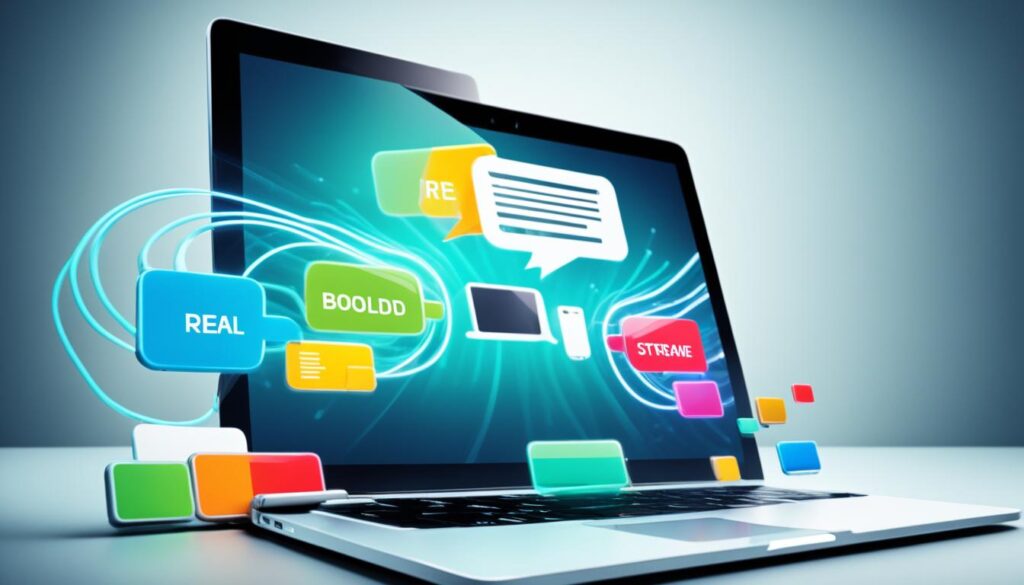Welcome to our article comparing email and live chat support as customer communication channels. In today’s digital age, providing efficient and effective support is crucial for businesses looking to enhance customer satisfaction and build strong relationships.
When it comes to customer communication, both email and live chat have their advantages. Understanding the difference between the two and knowing which one is best suited for your business can make a significant impact on customer experience and overall support efficiency.
Let’s explore the advantages of email and live chat support, and how they can benefit your business. By the end of this article, you’ll have a better understanding of which support channel is ideal for your specific needs.
In the first section, we’ll delve into the differences between email and live chat, highlighting their unique features and benefits. We’ll also compare customer satisfaction rates and usage statistics to provide useful insights into these communication channels.
Whether you’re considering email support or live chat support, this article will assist you in making an informed decision, ensuring your customer support meets and exceeds expectations. Let’s get started!
What is Traditional Live Chat?
Traditional live chat is a customer support channel that involves filling out a form and waiting for an agent to become available. This form of communication allows for real-time interaction between the customer and the agent, with the expectation of immediate responses. It is a popular choice for businesses seeking to meet customer expectations and provide seamless assistance.
When using traditional live chat, customers can discuss their issues or ask questions directly with a support representative. The chat session unfolds in real-time, allowing for quick back-and-forth exchanges. This type of communication is particularly effective for urgent situations where a prompt response is necessary to resolve an issue.
One advantage of traditional live chat is its higher customer satisfaction ratings compared to other communication channels. The ability to engage in real-time conversation and receive immediate assistance contributes to a positive customer experience. However, it’s important to note that if the chat session ends without a resolution, the customer may be required to initiate a new chat session.
Overall, traditional live chat is a valuable tool for businesses looking to meet customer expectations and ensure customer satisfaction. Its real-time nature allows for efficient support, while its higher satisfaction ratings demonstrate its effectiveness.
What is Real Time Messaging?
Real-time messaging is a versatile customer communication channel that offers a dynamic and responsive way for businesses to interact with their customers. Unlike traditional live chat, real-time messaging allows customers to initiate conversations without knowing if an agent is immediately available. Instead, they may see a message indicating an estimated response time.
This form of messaging provides customers with the flexibility to communicate at their convenience, across different website visits and devices. It offers a seamless experience similar to chatting on popular platforms like Facebook Messenger or WhatsApp.

Real-time messaging meets customer expectations for quick and efficient support while providing the convenience of asynchronous communication. By allowing customers to exchange messages at their own pace, real-time messaging ensures that they have ample time to formulate their questions and fully express their concerns. This can lead to higher customer satisfaction levels.
Real-time messaging also fosters a sense of continuity in customer conversations. Unlike traditional live chat where the chat session ends when the customer closes the chat window, real-time messaging allows customers to pick up where they left off. They can easily refer back to previous conversations and continue the dialogue without repeating information, enhancing efficiency in customer support.
Implementing real-time messaging as part of your customer support strategy can help improve customer satisfaction, increase engagement, and build stronger customer relationships. With its ability to meet the ever-increasing demands of modern customers, real-time messaging is an essential tool for businesses striving to provide exceptional customer experiences.
How Do Live Chat and Messaging Compare?
When it comes to customer communication channels, both live chat and messaging have their strengths and features that cater to different customer preferences. Let’s delve into the comparison between live chat and messaging to understand how each option differs and what benefits they offer.
Live chat and messaging both provide chat widgets that can be integrated into websites or mobile apps, allowing customers to engage in real-time conversations with support agents. However, there are key distinctions to consider when evaluating these communication channels.
Live Chat:
Live chat operates on the premise of immediate responses from customer support agents. It is characterized by a clear beginning and end to each chat session, ensuring that customers receive prompt assistance.
During a live chat session, customers can ask questions, seek resolution to their issues, and receive instant replies from agents. This real-time interaction fosters a sense of urgency and quick problem-solving.
However, it is important to note that live chat conversations are typically only visible during the session and are not easily accessible after the chat ends. This makes it challenging for customers to review previous conversations or retrieve important information.
Messaging:
Messaging, on the other hand, offers a more flexible approach to customer communication. It allows for asynchronous conversations, meaning that both customers and agents can respond at their convenience.
With messaging, customers can start a conversation and receive an estimated response time, allowing them to continue with other activities while waiting for a reply. This convenience appeals to customers who have multiple obligations and prefer not to be bound by immediate responses.
Additionally, messaging platforms typically provide customers with a chat history, enabling them to refer back to previous conversations and easily access relevant information. This feature enhances customer satisfaction by allowing them to review important details and follow up on previous discussions.
Moreover, messaging offers cross-device support, enabling customers to seamlessly switch between different devices and continue their conversation without interruption. This flexibility caters to the needs of customers who utilize multiple devices throughout their daily activities.

When comparing live chat and messaging, it is essential to understand customer preferences and the specific requirements of your business. While live chat excels in providing immediate assistance, messaging offers the convenience of asynchronous communication, chat history, and cross-device support.
| Live Chat | Messaging |
|---|---|
| Immediate responses | Asynchronous communication |
| Clear beginning and end to each chat session | No clear finish point |
| Chat conversations visible only during the session | Chat history for easy reference |
| N/A | Cross-device support |
Considering these factors will help you determine which communication channel aligns best with your customers’ preferences and provides the necessary features to enhance their experience.
Benefits of Live Chat Support
Live chat support offers several benefits that can greatly improve your business’s customer service and overall success. By implementing live chat support on your website, you can enjoy increased customer satisfaction and retention rates, leading to higher customer loyalty and increased sales.
One of the key advantages of live chat support is its ability to provide quick and efficient assistance to your customers. With live chat, customers can easily reach out to your support team and receive real-time responses, eliminating the wait time associated with other communication channels like email or phone calls. This immediate support can greatly enhance the customer experience and ensure their issues are resolved promptly.
Moreover, live chat support offers a cost-effective solution for providing excellent customer service. Compared to other channels, such as phone support or in-person interactions, live chat support requires fewer resources and can handle multiple customer inquiries simultaneously. This makes it a highly efficient and cost-effective support option for businesses of all sizes.
Furthermore, live chat support enables increased customer engagement. By offering a live chat feature on your website, you encourage customers to actively engage with your brand and seek assistance when needed. This not only strengthens the relationship between your business and its customers but also provides valuable opportunities for upselling, cross-selling, and gathering feedback that can further drive sales and improve your products or services.
To illustrate the benefits of live chat support, take a look at the following table:
| Benefits | Live Chat Support |
|---|---|
| Increased Customer Satisfaction | ✓ |
| Improved Customer Retention | ✓ |
| Increased Sales | ✓ |
| Cost-Effective Support | ✓ |
| Improved Efficiency | ✓ |
| Increased Customer Engagement | ✓ |
As you can see from the table, live chat support offers numerous advantages that can significantly benefit your business. It enhances customer satisfaction, increases customer retention, boosts sales, provides cost-effective support, improves operational efficiency, and fosters greater customer engagement.
By incorporating live chat support into your customer service strategy, you can take your business to new heights and gain a competitive edge in today’s digital landscape.

Benefits of Phone Support
When it comes to providing customer support, phone support remains a popular and effective tool that offers unique advantages for businesses. By leveraging phone support, you can enhance the personal interaction between your support representatives and customers, leading to improved customer satisfaction and loyalty.
One of the key benefits of phone support is the ability to achieve quick resolutions for complex issues. Unlike other communication channels, such as email or live chat, phone support allows for real-time conversations where customers can explain their problems and receive immediate assistance. This not only reduces customer frustration but also enables your team to address issues promptly, ensuring a smooth and efficient customer experience.
“Phone support allows for real-time conversations, enabling quick resolutions for complex issues.”
In addition to quick problem-solving, phone support facilitates clear communication in real time. With voice conversations, customers can convey their questions, concerns, and expectations more accurately, avoiding misunderstandings that may occur through written communication. The clarity achieved through phone support enhances the quality of interactions, leading to a better overall customer experience.
Furthermore, phone support provides an excellent opportunity for businesses to gather valuable customer feedback. By engaging in direct conversations with customers, you can gain insights into their preferences, pain points, and suggestions. This feedback not only helps you improve your product or service offerings but also demonstrates your commitment to listening and adapting to your customers’ needs.
“Phone support enables businesses to receive valuable customer feedback and build trust.”
Building trust is a crucial aspect of any customer relationship, and phone support plays a vital role in trust-building. By offering a human connection and personalized assistance, phone support establishes a sense of reliability and credibility in the eyes of your customers. They feel valued and understood, fostering a deeper level of trust and loyalty towards your brand.
Despite the rise of digital communication channels, phone support remains an indispensable tool for businesses that prioritize clear and immediate communication, personal interaction, and trust-building. By leveraging phone support alongside other customer communication channels, you can create a comprehensive support system that caters to the diverse needs and preferences of your customers.
Key Benefits of Phone Support:
- Personal interaction between customers and support representatives
- Quick resolution of complex issues
- Clear communication in real time
- Opportunity for businesses to receive valuable customer feedback
- Trust-building and establishment of credibility
Live Chat Support or Phone Support: Which is Better for Your Business?
When it comes to customer support, choosing between live chat support and phone support can be a challenging decision. Both channels have their own advantages and considerations. To make the right choice for your business, it’s important to consider several factors, including the speed of response required, the complexity of the issues, customer preferences, language barriers, and cost.
If your business prioritizes quick response times and efficient issue resolution, live chat support may be the preferred option. With live chat, customers can receive immediate assistance, allowing for faster problem-solving. It is especially suitable for simpler issues that can be resolved in real-time.
On the other hand, phone support offers a more in-depth problem-solving approach and provides a personal touch to customer interactions. It allows for clear and direct communication in real-time, making it ideal for complex issues that require detailed explanations or troubleshooting. Phone support also provides an opportunity to build trust and rapport with customers through personal interactions.
Customer preferences should also be taken into account. Some customers may prefer the convenience and speed of live chat, while others may feel more comfortable speaking with a support representative over the phone. Understanding your customer base and their preferences can help you make an informed decision.
Language barriers can also play a role in choosing between live chat and phone support. If your customer base consists of individuals who speak different languages, live chat may offer the advantage of utilizing translation tools or providing text-based interactions that can be easily understood by customers in their native language. On the other hand, phone support allows for immediate communication and can be useful when language barriers are not a concern.
Cost is another factor to consider. Live chat support can be more cost-effective compared to phone support, as it requires fewer resources and can handle multiple interactions simultaneously. However, phone support may be necessary for businesses that prioritize personalization and detailed support, even if it comes at a higher cost.
Ultimately, the choice between live chat support and phone support should be based on the specific needs of your business and the preferences of your customers. By considering the speed of response, complexity of issues, customer preferences, language barriers, and cost, you can make an informed decision that aligns with your business goals and delivers exceptional customer support.
| Factor | Live Chat Support | Phone Support |
|---|---|---|
| Speed of Response | Fast | Immediate |
| Complexity of Issues | Simple to moderate | Complex |
| Customer Preferences | Prefer convenience and speed | Prefer personal interaction |
| Language Barriers | Translation tools available | Immediate communication |
| Cost | Cost-effective | Potentially higher cost |
Conclusion
After weighing the advantages and disadvantages, it is clear that both live chat support and phone support have their merits in providing excellent customer service. Live chat support offers quick and efficient assistance, ensuring that customer needs are met promptly. It enhances the overall customer experience and is a cost-effective solution for businesses.
On the other hand, phone support provides a more personal touch, allowing for direct communication between customers and support representatives. It excels in resolving complex issues quickly and effectively. Phone support also provides a valuable opportunity for businesses to collect customer feedback and build trust.
The choice between live chat support and phone support ultimately depends on the specific needs of your business and the preferences of your customers. Consider factors such as the speed of response required, the complexity of the issues, language barriers, and cost. Both options can enhance your customer service efforts when implemented correctly.
Remember, regardless of the support channel you choose, the most important aspect is to prioritize excellent customer service. By providing prompt, efficient, and personalized assistance, you can build strong relationships with your customers and ensure their satisfaction.
FAQ
What is the difference between email and live chat?
Email is a communication channel that allows for asynchronous messaging, while live chat provides real-time communication with immediate responses expected.
What are the advantages of email support?
Email support allows for more time to craft detailed responses, provides a written record of communication, and allows for attachment of documents or screenshots.
What are the advantages of live chat support?
Live chat support offers immediate responses, real-time problem-solving, higher customer satisfaction ratings, and the ability to engage with customers in a more interactive way.
What is traditional live chat?
Traditional live chat involves customers filling out a form and waiting for an agent to become available for real-time communication.
What is real-time messaging?
Real-time messaging allows customers to fill out a form without knowing if an agent is available, providing more flexibility in terms of response times and the ability to chat across website visits and devices.
How do live chat and messaging compare?
Live chat requires immediate responses and has a clear beginning and end, while messaging allows for more asynchronous communication and provides a chat history that customers can refer back to.
What are the benefits of live chat support?
Live chat support offers increased customer satisfaction and retention rates, quick and efficient assistance, cost-effectiveness, improved support operations, and stronger customer engagement.
What are the benefits of phone support?
Phone support provides a more personal interaction, allows for quick resolution of complex issues, enables clear communication in real-time, provides an opportunity for customer feedback, and helps build trust with customers.
Which is better for your business, live chat support or phone support?
The choice depends on factors such as the speed of response required, the complexity of the issues, customer preferences, language barriers, and cost. Live chat support is generally faster and more suitable for simpler issues, while phone support allows for more in-depth problem-solving and personal interaction.
